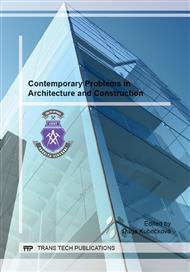p.540
p.545
p.550
p.556
p.561
p.566
p.573
p.579
p.585
Architectural Elements with Respect to the Energy Performance of Buildings
Abstract:
Buildings account for 40% of the primary energy use and 24%of the generation of green house gases worldwide. Therefore, a reduction of the specific energy demand of buildings and increased use of renewable energy are important measures of climate change mitigation. On the 18th of May 2010 a recast of the EPBD was approved which further clarifies the intention that buildings shall have a low energy demand. The recast of the EPBD specifies that by the end of 2020 all new buildings shall be “nearly zero-energy buildings”. A nearly zero-energy building is defined as a building with a very high energy performance and very simple shape. The current focusing on the energy efficiency of the building operation may lead to uniform cuboid architecture with heavy insulated building envelopes. The paper deals with the influence of energy concept on architectural elements (and their properties as shape, material, colour, texture etc.)
Info:
Periodical:
Pages:
561-565
Citation:
Online since:
October 2014
Authors:
Price:
Сopyright:
© 2014 Trans Tech Publications Ltd. All Rights Reserved
Share:
Citation:


